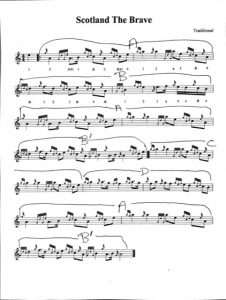Recently, I took a poll amongst fellow pipers and piping students in order to learn what kinds of problems/challenges they faced in learning to play the bagpipe. The biggest problems by far were memorization, musicality, and rhythm. Personally, I happen to believe all of those things are connected. Let’s work backwards:
What are you expecting to have happen when you memorize a tune? Are you expecting to see the sheet music on a cloud or do you have the song in your head? I think that most have the song tune in their head before it gets to their hands. As I think about my own students and their plight with memorization, I think that the problem is “not seeing the whole picture”. If you are trying to memorize “Scotland the Brave”, do you actually know how it goes totally, or are you hung up on e, g gracenote low A tourluath, c doubling e etc…. Can you actually sing Scotland the Brave? I find that if I can sing it, I can play it. We’ll talk more about that later.
Let’s say that you can sing it. Bagpipe music isn’t a symphony. It’s folk music. Folk music is pretty predictable. If we take Scotland the Brave apart, it actually consists of 2 measure phrases. Take a look at the picture that I have attached to this article. If you are looking at the music you could put an “A” over the first 2 measures, put a “B” over the 2nd two measures. When you get to measure 5, it restates phrase “A” and then finishes the first part with a modified version of “B” (B prime). The second part introduces a new phrase “C” followed by another new phrase “D” followed by A and B prime. If you learned the difference between B and B Prime, you then only need to learn 4 phrases to be able to memorize Scotland the Brave. Most 4/4 marches are played the same way. The “Blue Bells of Scotland” is A, B, A, B, C, D, A, B. It’s just like Scotland the Brave except no special ending on B. If you were to take a look at all of your 4/4 marches, you would find the same formula.
Let’s talk about singing the tunes. I teach rhythm syllables (1 e & uh, etc.) when I teach rhythm. The purpose is to have a stable tool to determine the duration of a note. It also creates lyrics so that when you’re singing Scotland the Brave, you aren’t just singing “dum dee dum”, which has no duration value to it. I can correct someone’s rhythm by singing the correct syllables to them and they understand what I want. Scotland the Brave becomes 1 2 uh 3 & 4 &, 1 2 3 & 4&, 1 2 uh 3 & 4 &, 1 2 3 uh 4 e & a, etc. Rhythm is essential to creating musical expression on the bagpipe. When I am playing the bagpipe, I am singing the tune in my head and fingering the song. See if you can complete writing in the rhythm to Scotland the Brave. All of the answers are there in the first 2 lines.
Musical expression – or musicality – on the bagpipe comes from the duration of the notes within a steady beat. You don’t need to be a Grade 1 piper technically to be a good musical player. You need to know how to use rhythm as a tool for expression and use it to develop your technique in the process. You also need musical perspective. You need to listen to all kinds of music, including classical music. Being musically-sophisticated makes you a better musician overall.
If you are interested in solving these problems, again it starts with rhythm. Below is a link to my “Intro to Rhythm” program. If you want to be good at rhythm, it takes a decision that you are going to conquer this problem. It’s not that hard! I’ll teach you how to conquer it with just a pencil! Are you ready to get started?

Scotland The Brave in phrases.


0 Comments